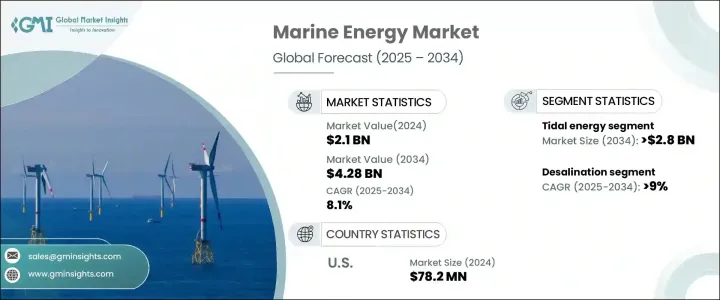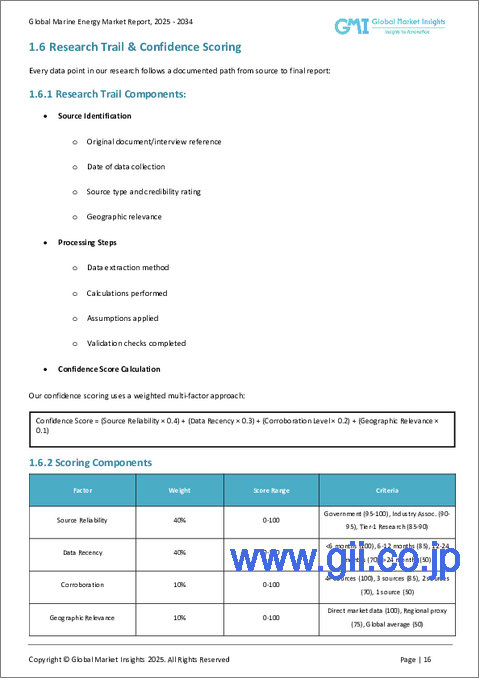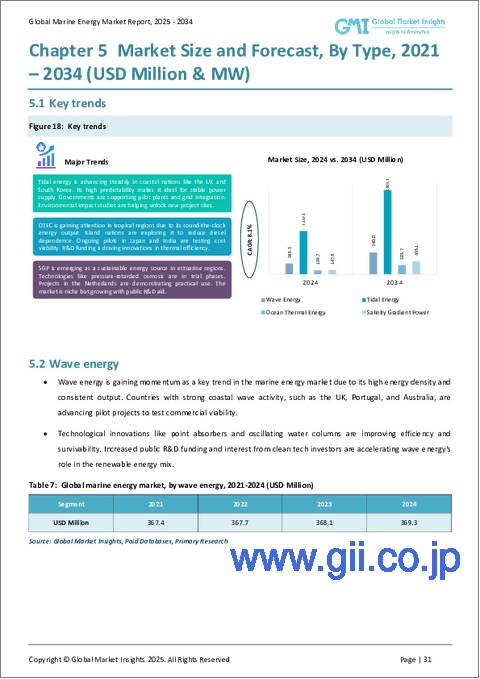|
|
市場調査レポート
商品コード
1699305
海洋エネルギー市場の機会、成長促進要因、産業動向分析、2025年~2034年の予測Marine Energy Market Opportunity, Growth Drivers, Industry Trend Analysis, and Forecast 2025-2034 |
||||||
カスタマイズ可能
|
|||||||
| 海洋エネルギー市場の機会、成長促進要因、産業動向分析、2025年~2034年の予測 |
|
出版日: 2025年02月20日
発行: Global Market Insights Inc.
ページ情報: 英文 127 Pages
納期: 2~3営業日
|
全表示
- 概要
- 目次
世界の海洋エネルギー市場は2024年に21億米ドルに達し、2025年から2034年にかけてCAGR 8.1%で拡大すると予測され、力強い成長が見込まれています。
世界がますますクリーンなエネルギー源へとシフトする中、海洋エネルギー技術は、その持続可能性、信頼性、カーボンフットプリントを削減する能力により、支持を集めています。安定した気候変動に強いエネルギー・ソリューションに対する需要の高まりは、市場拡大の大きな要因となっています。政府や民間企業は、安定した再生可能エネルギー源を提供する可能性を認識し、海洋発電プロジェクトへの投資を強化しています。

エネルギー変換システム、革新的な素材、最適化された展開戦略における進歩は、効率を高めコストを下げ、海洋エネルギーを従来の化石燃料に代わる実行可能なものにしています。広大な海岸線を持ち、波エネルギーの密度が高い国々は、この資源を利用する上で特に有利な立場にあります。現在進行中の研究開発努力は、海洋エネルギー技術をさらに洗練させ、発電、海水淡水化、工業プロセスへの新たな応用を可能にしています。この分野はまた、導入と商業化を促進する政策的インセンティブ、助成金、補助金からも恩恵を受けています。さらに、業界関係者と政府機関の戦略的協力関係も、技術革新を促進し、展開を加速させています。
| 市場範囲 | |
|---|---|
| 開始年 | 2024 |
| 予測年 | 2025-2034 |
| 開始金額 | 21億米ドル |
| 予測金額 | 42億8,000万米ドル |
| CAGR | 8.1% |
海洋エネルギー市場は、海洋温度差発電(OTEC)、波力発電、潮力発電、塩分濃度勾配発電(SGP)など、エネルギーの種類によって分類されます。なかでも潮汐エネルギーは、2034年までに28億米ドルに達し、優位を占めると予測されています。エネルギー密度が高いため、潮流が比較的弱い地域でもかなりの発電が可能であり、大規模な再生可能エネルギー発電プロジェクトに適しています。世界各国の政府は、潮汐エネルギーの採用を促進し、市場浸透を促進するために、補助金や助成金を含む有利な政策を実施しています。
用途の観点から見ると、海洋エネルギーは発電、淡水化、様々な産業プロセスに利用されています。発電分野は、2050年までにネットゼロ排出を達成するという世界のコミットメントの高まりに後押しされ、2024年の市場シェアは75.5%と圧倒的なシェアを占めています。発電のための輸入化石燃料への依存度の高まりは、温室効果ガスの排出を削減しながらエネルギー安全保障を強化するために海洋ベースのソリューションを探求するいくつかの国を奨励しています。海洋エネルギー・インフラへの投資は、特に潮汐・波浪エネルギー資源が豊富な地域で拡大しており、発電能力の向上と普及に貢献しています。
北米の海洋エネルギー市場は力強い成長が見込まれており、2024年のCAGRは9.3%と予測されています。米国の海洋エネルギー分野だけでも、複数の州が設定した野心的な再生可能エネルギー目標に後押しされ、2024年の市場規模は7,820万米ドルとなりました。米国海軍は沿岸施設や遠隔操作のための海洋発電ソリューションを模索しており、市場拡大に弾みをつけています。最先端の海洋エネルギー技術に対する民間セクターの投資も増加傾向にあり、業界の成長可能性をさらに確固たるものにしています。その結果、北米は、再生可能エネルギー・ミックスを強化する波力・潮力発電システムの配備拡大とともに、海洋エネルギーの進歩にとって重要な地域となりつつあります。
目次
第1章 調査手法と調査範囲
- 市場の定義
- 基本推定と計算
- 予測計算
- 1次調査と検証
- 市場定義
第2章 エグゼクティブサマリー
第3章 業界洞察
- 業界エコシステム
- 規制状況
- 業界への影響要因
- 促進要因
- 業界の潜在的リスク&課題
- 成長可能性分析
- ポーター分析
- PESTEL分析
第4章 競合情勢
- イントロダクション
- 戦略ダッシュボード
- イノベーションと持続可能性の展望
第5章 市場規模・予測:タイプ別、2021年~2034年
- 主要動向
- 波力エネルギー
- 潮汐エネルギー
- 海洋温度差発電(OTEC)
- 塩分濃度勾配発電(SGP)
第6章 市場規模・予測:用途別、2021年~2034年
- 主要動向
- 発電
- 海水淡水化
- その他
第7章 市場規模・予測:地域別、2021年~2034年
- 主要動向
- 北米
- 米国
- カナダ
- 欧州
- フランス
- スペイン
- 英国
- ノルウェー
- アジア太平洋
- 中国
- インド
- 韓国
- 世界のその他の地域
第8章 企業プロファイル
- BioPower Systems
- Carnegie Clean Energy
- CorPower Ocean
- Minesto
- Marine Energy Group
- Nova Innovations
- Ocean Renewable Power Company
- Orbital Marine Power
- SSE Renewables
- SINN Power
The Global Marine Energy Market reached USD 2.1 billion in 2024 and is set for robust growth, projected to expand at a CAGR of 8.1% between 2025 and 2034. As the world increasingly shifts toward cleaner energy sources, marine energy technologies are gaining traction due to their sustainability, reliability, and ability to reduce carbon footprints. The rising demand for stable and climate-resilient energy solutions is a significant driver for market expansion. Governments and private sector entities are ramping up investments in marine power projects, recognizing their potential to provide a steady and renewable energy source.

Advancements in energy conversion systems, innovative materials, and optimized deployment strategies are enhancing efficiency and lowering costs, making marine energy a viable alternative to traditional fossil fuels. Countries with extensive coastlines and high wave energy densities are particularly well-positioned to harness this resource. Ongoing research and development efforts are further refining marine energy technologies, unlocking new applications in power generation, desalination, and industrial processes. The sector is also benefitting from policy incentives, grants, and subsidies that encourage adoption and commercialization. Additionally, strategic collaborations between industry players and government bodies are fostering innovation and accelerating deployment.
| Market Scope | |
|---|---|
| Start Year | 2024 |
| Forecast Year | 2025-2034 |
| Start Value | $2.1 Billion |
| Forecast Value | $4.28 Billion |
| CAGR | 8.1% |
The marine energy market is categorized by energy types, including ocean thermal energy conversion (OTEC), wave energy, tidal energy, and salinity gradient power (SGP). Among these, tidal energy is projected to dominate, reaching USD 2.8 billion by 2034. Its high energy density enables substantial power generation even in areas with relatively low tidal currents, making it a preferred choice for large-scale renewable energy projects. Governments worldwide are implementing favorable policies, including subsidies and grants, to boost tidal energy adoption and drive market penetration.
From an application perspective, marine energy is utilized for power generation, desalination, and various industrial processes. The power generation segment accounted for a dominant 75.5% market share in 2024, driven by increasing global commitments to achieving net-zero emissions by 2050. The rising dependence on imported fossil fuels for electricity generation has encouraged several nations to explore marine-based solutions to enhance energy security while reducing greenhouse gas emissions. Investments in marine energy infrastructure are expanding, particularly in regions with abundant tidal and wave energy resources, contributing to higher generation capacities and widespread adoption.
North America marine energy market is positioned for strong growth, with a projected CAGR of 9.3% in 2024. The US marine energy sector alone was valued at USD 78.2 million in 2024, driven by ambitious renewable energy targets set by multiple states. The US Navy is exploring marine power solutions for coastal installations and remote operations, adding momentum to market expansion. Private sector investments in cutting-edge marine energy technologies are also on the rise, further solidifying the industry's growth potential. As a result, North America is emerging as a key region for marine energy advancements, with increasing deployment of wave and tidal power systems enhancing the renewable energy mix.
Table of Contents
Chapter 1 Methodology & Scope
- 1.1 Market definitions
- 1.2 Base estimates & calculations
- 1.3 Forecast calculation
- 1.4 Primary research & validation
- 1.4.1 Primary sources
- 1.4.2 Data mining sources
- 1.5 Market definitions
Chapter 2 Executive Summary
- 2.1 Industry synopsis, 2021 – 2034
Chapter 3 Industry Insights
- 3.1 Industry ecosystem
- 3.2 Regulatory landscape
- 3.3 Industry impact forces
- 3.3.1 Growth drivers
- 3.3.2 Industry pitfalls & challenges
- 3.4 Growth potential analysis
- 3.5 Porter's analysis
- 3.5.1 Bargaining power of suppliers
- 3.5.2 Bargaining power of buyers
- 3.5.3 Threat of new entrants
- 3.5.4 Threat of substitutes
- 3.6 PESTEL analysis
Chapter 4 Competitive landscape, 2024
- 4.1 Introduction
- 4.2 Strategic dashboard
- 4.3 Innovation & sustainability landscape
Chapter 5 Market Size and Forecast, By Type, 2021 – 2034 (USD Million & MW)
- 5.1 Key trends
- 5.2 Wave energy
- 5.3 Tidal energy
- 5.4 Ocean thermal energy conversion (OTEC)
- 5.5 Salinity Gradient Power (SGP)
Chapter 6 Market Size and Forecast, By Application, 2021 – 2034 (USD Million & MW)
- 6.1 Key trends
- 6.2 Power generation
- 6.3 Desalination
- 6.4 Others
Chapter 7 Market Size and Forecast, By Region, 2021 – 2034 (USD Million & MW)
- 7.1 Key trends
- 7.2 North America
- 7.2.1 U.S.
- 7.2.2 Canada
- 7.3 Europe
- 7.3.1 France
- 7.3.2 Spain
- 7.3.3 UK
- 7.3.4 Norway
- 7.4 Asia Pacific
- 7.4.1 China
- 7.4.2 India
- 7.4.3 South Korea
- 7.5 Rest of World
Chapter 8 Company Profiles
- 8.1 BioPower Systems
- 8.2 Carnegie Clean Energy
- 8.3 CorPower Ocean
- 8.4 Minesto
- 8.5 Marine Energy Group
- 8.6 Nova Innovations
- 8.7 Ocean Renewable Power Company
- 8.8 Orbital Marine Power
- 8.9 SSE Renewables
- 8.10 SINN Power





